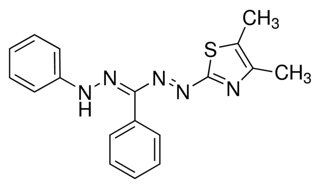 Tetrazolium reduction assays are characterized by reduction of various tetrazolium analogs (MTT, MTS, XTT, WST-1, and INT) and quantification of the subsequent color change. The MTT (3-(4,5-dimethylthiazol-2-yl)-2,5-diphenyltetrazolium bromide) assay was originally developed as an alternative to the radioactive thymidine incorporation assay. It was one of the first assays to be developed for the 96-well plate format intended for high throughput screening in 1983 by Tim Mossman. The MTT assay differs slightly from the radioactive thymine incorporation assay as the MTT assay measures the cell viability of a solution as opposed to cell proliferation. This assay is therefore is an incredibly useful tool in determining drug cytotoxicity or differentiating between multiple cell lines.
Tetrazolium reduction assays are characterized by reduction of various tetrazolium analogs (MTT, MTS, XTT, WST-1, and INT) and quantification of the subsequent color change. The MTT (3-(4,5-dimethylthiazol-2-yl)-2,5-diphenyltetrazolium bromide) assay was originally developed as an alternative to the radioactive thymidine incorporation assay. It was one of the first assays to be developed for the 96-well plate format intended for high throughput screening in 1983 by Tim Mossman. The MTT assay differs slightly from the radioactive thymine incorporation assay as the MTT assay measures the cell viability of a solution as opposed to cell proliferation. This assay is therefore is an incredibly useful tool in determining drug cytotoxicity or differentiating between multiple cell lines.
Unlike other tetrazolium compounds in other assays MTT can readily pass through the plasma membrane of eukaryotic cells. This allows MTT to be reduced in the cytoplasm whereas other tetrazolium compounds need to be reduced by electrons transported out of the cell by intermediary electron acceptors. This reduction occurs because of dehydrogenase enzymes only present in viable cells which reduce the yellow MTT to purple insoluble formazan crystals which accumulate inside the cell. These formazan crystals must be solubilized before an absorbance reading at 570 nm can be taken and there are many ways to do this such as adding acidified isopropanol, DMSO, DMF, or SDS. The assay relies on the principle that the darker the purple color, the more metabolically active cells present.
Some things to keep in mind while performing the MTT assay is that both MTT and the formazan product are toxic to cells and care should be taken when choosing to use this assay. Cell death may be caused by the assay itself instead of the experimental stressor and the assay would therefore underestimate cell viability results. In addition MTT causes noticeable changes in cell morphology which implies changed physiology which may impact the results of the assay. Reducing agents can interfere with this assay and may reduce MTT to formazan and cause a higher than expected signal and therefore care should be taken when choosing a buffer in which to run this assay. Furthermore, a basic assay environment and exposure to light can cause spontaneous reduction of MTT and again cause a higher than normal signal to develop. If the assay is carefully optimized for the particular situation it is being used in the MTT assay is an incredibly useful assay for determining cell viability because of its simplicity, speed, and ease at which it can be performed and its compatibility with high throughput screening.






